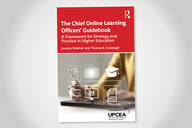You have /5 articles left.
Sign up for a free account or log in.
Now is the time to plan for the post-pandemic university. Too early, you say? Still in the midst of managing the low-density university amid surging COVID-19 cases?
I never said it would be easy to plan for the post-COVID university. I am saying that the time to do so is before the pandemic ends so that whenever that shift occurs, your school will be able to hit the ground running. Failure to plan now for life after the pandemic is the fastest path toward regression to pre-pandemic norms.
What should be on the list of every post-COVID-19 university?
One idea that I’d like to nominate for consideration would be a commitment to design every course as an online course. That’s right, every single course. Even if there are no current plans to expand online offerings in, say, a core undergraduate residential program, my recommendation is to still design those face-to-face courses for online delivery. Each and every single one. Here’s why.
No. 1: Resiliency
Obviously, a course designed for online delivery will more easily be able to pivot to remote, should we ever need to make that pivot again. We learned from COVID that smart institutions make significant investments in preparing for low-probability/high-impact events. The next black swan that causes all courses to toggle from residential to remote may not be a pandemic, but it might be a wildfire, a hurricane or an earthquake. The ability to seamlessly move between residential and online delivery modes is the best guarantee for resiliency in an uncertain world.
No. 2: Flexibility
Current plans may not envision shifting core residential programs online, but plans can change. Professors and students now have some experience with remote learning. It is less of a stretch to think about moving part or all of a degree online. We may see rapid growth in summer online offerings, complemented by online courses between the fall and spring terms. Students vote with their feet, looking for schools that offer the flexibility of both residential and online offerings. Colleges and universities can prepare for this shift by designing all courses to work both face-to-face and online.
No. 3: Quality
Every instructional designer knows that there is fundamentally no difference in the design of an online and a face-to-face course. There are not residential and online courses. Instead, there are well-designed courses and poorly designed courses. A well-designed course is built around learners and learning, rather than content. When professors work with an instructional designer, they end up with a course that is backward designed around learning objectives, not content. Good courses feature opportunities for learners to actively construct knowledge rather than passively absorb materials. Good courses utilize assessments for learning as well as evaluation. The best courses are immersive, built for faculty presence and student engagement. A course designed around the core principles of learning science and instructional design will pivot seamlessly between face-to-face and online modalities.
No. 4: Extensibility
The future of higher education belongs not to the credit hour but the competency. The fastest growth in postsecondary educational offerings is occurring not at the degree but the alternative credential. Certificates and other certifications of competency, almost always created for an online offering, are rapidly gaining acceptance by employers. This does not mean that schools should abandon their credit-bearing courses that lead to degrees. Instead, schools should offer both noncredit/nondegree online programs and credit-bearing courses and degrees. Alternative credentials are not a competitor to degrees. They are a funnel. Designing all courses for online delivery will make it easier to unpack and repack materials into alternative credentials. The name of the game is blending, remixing and reuse. Even if the original use is face-to-face, courses born online lend themselves to transformation for alternative online offerings.




